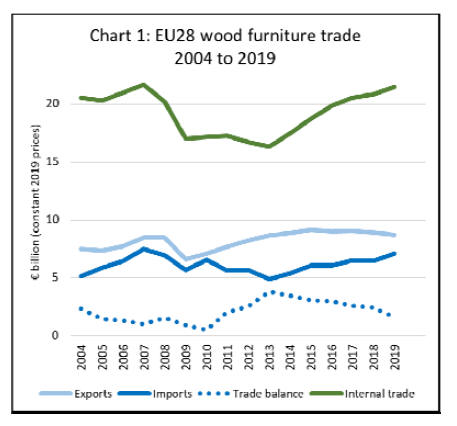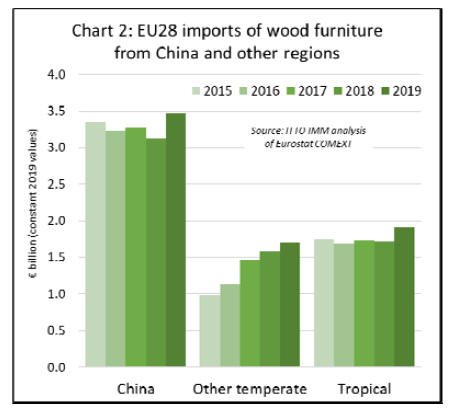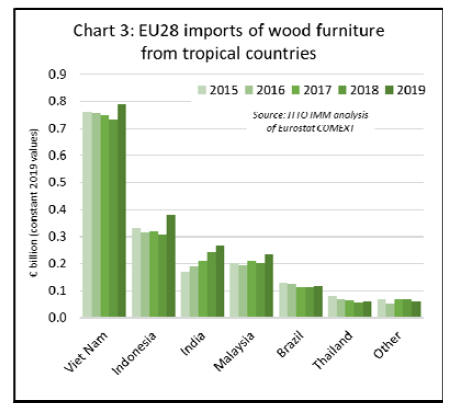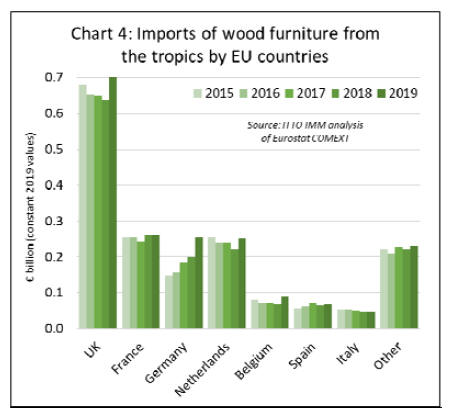|
Report from
Europe
EU wooden furniture imports last year at highest level
since 2007
It is ironic that in 2019, just before the market chaos
created by COVID-19, the EU recorded its strongest year
for wooden furniture imports since 2007. That was, of
course, when the last consumer boom was at its peak just
prior to the market meltdown of the financial crises.
The EU imported wooden furniture from outside the bloc
with a total value of €7.07 billion in 2019, 10% more than
the previous year. Last year was only the second time in
history, alongside 2007, when annual imports of wooden
furniture into the EU exceeded €7 billion (at constant 2019
prices) (Chart 1).

Several factors on both the supply and demand side
combined to drive growth in EU imports of wooden
furniture in 2019. Last year was the culmination of a
period of slow but consistent expansion of the EU
economy which began five years before in 2014.
The slow growth in EU imports was interrupted in the
second half of 2018, particularly in the UK owing to
Brexit uncertainty, which in retrospect turned out to be an
over adjustment and led to increased imports last year.
At the same time China, embroiled in a bitter trade dispute
with the U.S. during 2019, was looking to the EU as an
alternative outlet for furniture products. Meanwhile,
several tropical suppliers ¨C notably Vietnam, Indonesia
and India - were also seeking to build on new investment
in capacity and to diversify markets by targeting the EU.
The long-term trend towards increased imports from
several neighbouring countries on the Eastern borders of
the EU, notably Turkey, Bosnia, Ukraine, Serbia and
Belarus, also continued last year.
Economic integration drives strong EU internal
furniture trade in 2019
The trade data suggests that there was a real increase in
EU consumption of wooden furniture in 2019. This is
implied not only by rising imports from outside the region,
but also by a resumption of the rising trend in internal EU
trade of wooden furniture during the year.
This last trend which also began in 2014 had slowed in
2018 but picked up again in 2019. In 2019, internal EU
trade in wooden furniture was valued at €21.46 billion, 3%
more than in 2018 and 23% greater than 5 years before.
Rising internal EU trade in wooden furniture is being
driven by increased market integration within the region,
the shift in manufacturing from higher cost countries in the
western EU to lower cost eastern locations, particularly
Poland, and the growing presence and influence of largescale
retailing chains operating at cross country level, most
notably IKEA.
More wooden furniture imports into the EU from outside
the region are also now being funneled via larger ports in
Western Europe, particularly the Netherlands and
Belgium, before being redistributed to other parts of the
EU.
The drive towards greater integration in the EU furniture
market and access to relatively lower cost manufacturing
locations in the eastern EU, explains the continuing
dominance of EU-based manufacturers in the region.
ITTO¡¯s own estimates based on analysis of Eurostat data
indicate that EU-based manufacturers account for around
85% of all wooden furniture sold in the region.
In recent years, European manufacturers have boosted
productivity and competitiveness through investment in
more advanced computer-controlled and automated
manufacturing, cutting overheads and reducing the relative
labour cost advantages of overseas producers.
There¡¯s been a particularly large investment by Western
European furniture manufacturers in Eastern European
countries, notably since their accession into the EU from
2004, and this is now maturing. From being principally
production satellites for large western European brands,
Eastern European manufacturers are now developing their
own identity and market momentum.
Furniture manufacturers in the EU area are also making a
virtue of their shorter supply chains which not only reduce
transport costs but also allow products to be delivered
more rapidly.
External suppliers face other more direct challenges to
expanding sales in the EU. Despite some recent
consolidation, there is still a relatively high degree of
fragmentation in the retailing sector in many European
countries which complicates market access. Many
overseas suppliers remain reliant on agents and lack direct
access to information on fashions and other market trends.
The progressive migration of European furniture sales
online has also tended to favour local manufacturers better
placed to meet the short lead times demanded by internet
retailers and consumers.
Another fall in EU wooden furniture exports
Nevertheless, the gradual rise in EU imports of wooden
furniture since 2014 suggests that external suppliers are
becoming progressively more competitive in this market.
Their heightened competitiveness is also suggested by the
fact that EU manufacturers have been struggling to expand
sales outside the region. Last year the value of EU wooden
furniture exports to non-EU countries fell 2.3% to €8.68
billion.
This continues a trend of flat-lining, or slowly declining
exports to countries outside the EU after reaching an alltime
high of just over €9 billion in 2015. Since then the
competitive benefits of the relative weakness of the euro
against the dollar and other cost saving efforts of EU
wooden furniture manufacturers have waned.
Competition for EU-based manufacturers has intensified
from newly emerging producers in Eastern European
countries outside the EU and from Vietnam which in the
last 5 years has rapidly overtaken all other tropical
countries in the global league table of wooden furniture
producing nations.
EU wooden furniture manufacturers have suffered in
higher-end export markets in Asia, the CIS and Middle
East from a range of factors including cooling of the
Chinese economy, the diversion of Chinese products away
from the US to other markets, a sharp fall in global equity
markets towards the end of 2018, extreme weakness of the
Russian rouble, relatively low oil prices and political
instability.
Overall, the combined effects of rising EU imports and
declining exports is that the total EU external trade
balance in wooden furniture fell 35% from €2.45 billion in
2018 to €1.61 billion last year.
Surge in EU wooden furniture imports from China in
2019
EU wooden furniture imports from China, by far the
largest external supplier, surged 11% to €3.46 billion in
2019, the highest level since 2010 (at constant prices)
(Chart 2). EU imports of upholstered seats with wooden
frames from China increased 14% to €1367 million, while
imports of wood dining room furniture were up 2% to
€515 million, bedroom furniture increased 19% to €419
million, and non-upholstered seating increased 11% to
€202 million.

During 2019, imports of Chinese wooden furniture were
particularly strong into the UK, rising 14% to €1273
million, the Netherlands, where they increased 23% to
€292 million, and Belgium with a 12% rise to €131
million.
Perhaps more surprising than for these countries which are
traditionally large furniture traders was a sharp rise in
imports of Chinese furniture last year by EU counties
which are themselves large manufacturers. Imports
increased by 20% to €130 million in Italy and by 28% to
€102 million in Poland.
Last year EU imports of wooden furniture also continued
to rise from temperate countries other than China, mainly
bordering the EU. Total EU imports from these countries
increased 7% to €1.7 billion, double the level of only five
years before. Last year imports increased 21% from
Turkey to €262 million, 5% from Bosnia to €239 million,
28% from Ukraine to €217 million, 17% from Serbia to
€159 million, and 26% from Belarus to €149 million.
Much of the rise in EU imports from these Eastern
temperate neighbours last year was destined for Germany,
France, Poland, Romania and Croatia. In contrast the UK,
which has historically been the largest EU importer of
wooden furniture from outside the region, continues to
import very little from these countries (excepting Turkey)
and has continued to be much more oriented towards
Asian suppliers.
Vietnam and Indonesia drive 11% rise in EU wooden
furniture imports from tropics
The EU imported wooden furniture from tropical countries
with a total value of €1.91 billion in 2019, up 11%
compared to the previous year. The main South East
Asian supply countries all followed a similar trajectory in
the EU wooden furniture market in the last five years. A
period of flat or declining imports between 2015 and 2018
was followed by a sharp upturn in 2019 (Chart 3).

After falling 2% to €733 million in 2018, EU imports from
Vietnam rebounded by 8% to €789 million in 2019, with
much of this growth in the UK which accounted for over
40% of all EU imports from Vietnam last year.
Around a third of EU furniture imports from Vietnam
comprise ¡°Other products not elsewhere stated¡± (i.e. not
seats or bedroom, dining room, office or shop furniture),
likely to consist largely of garden furniture manufactured
almost exclusively from tropical timber which is not
identified separately.
The second largest category of EU import from Vietnam
comprises dining room furniture, accounting for around
one quarter of total EU imports from the country.
This product group is likely to be manufactured from a
mix of temperate and tropical plantation species, such as
acacia and rubberwood.
Following a decline of 4% in 2018, EU imports of wooden
furniture from Indonesia increased 23% to €379 million in
2019. Unlike Vietnam, where other plantation wood and
imported temperate hardwoods are widely used, most
products imported into the EU from Indonesia comprise
plantation teak.
EU imports of Indonesian non-upholstered seating
increased 39% to €109 million while imports of ¡°other not
elsewhere stated¡± wooden furniture (i.e. primarily tables
and other items for exterior use) increased 30% to €154
million.
The rapid increase in imports of Indonesian garden
furniture products in 2019, a sector which has been a key
focus of environmental campaigning in the past, suggests
that FLEGT licensing may be playing an important role to
increase their competitiveness in the EU market,
particularly following efforts by EU authorities to tighten
implementation of the EU Timber Regulation in recent
years.
This is also suggested by the fact that the increased
imports from Indonesia in 2019 were destined mainly for
the Netherlands and, to a lesser extent, UK, Belgium and
Germany, all markets where certification has been
particularly important for market development.
EU imports of wooden furniture from Malaysia, which
mainly comprises rubberwood product for interior use at
the lower end of the price spectrum, increased 18% to
€236 million in 2019. EU imports for Malaysia of wood
bedroom furniture increased 27% to €96 million, wood
dining furniture was up 23% to €48 million, while nonupholstered
seating rose 13% to €48 million.
EU wooden furniture imports from India continued to rise
last year, up 11% to €268 million building on a 15% gain
in 2018. Imports from India mainly consist of products
made from local plantation species such as mango,
sheesham, acacia and rubberwood, often in rustic style
which are hand-crafted and for which formal quality
standards were not high.
Usage of sheesham for Indian furniture manufacturing has
been declining, as it is a CITES-listed Dalbergia species,
while use of mango has been rising in recent years.
There were also shifts in the destinations for wooden
furniture imported into the EU from tropical countries in
2019. Imports in the UK, by far the largest market, were
€703 million last year, 11% more than in 2018.
There was also a particularly large rise in imports by
Germany, up 29% to €256 million, with significant gains
in German imports from Vietnam, India and Indonesia.
Imports of tropical wooden furniture into the Netherlands
increased 14% to €252 million last year, with imports
from Indonesia up nearly 70% at €117 million. Imports of
tropical wooden furniture into Belgium were up 30% in
2019, with imports from Indonesia rising 28% to €41
million. Imports of tropical wooden furniture into France
were level at €261 million last year.

Furniture sector particularly hard hit by pandemic
It is far too early to assess the full impact of COVID-19 on
EU furniture imports this year, but early signs are that the
downturn will be at least as great as during the financial
crises of 2008-2009.
With its trade fairs cancelled, showrooms shuttered and
deliveries of larger items largely curtailed due to social
distancing, the furniture industry in Europe has been
particularly badly hit by current restrictions on trade and
travel. Brands that were already in a perilous position,
such as Lombok and Laura Ashley in the UK, have started
to collapse.
According to a study quoted by Statista on the projected
impact of COVID-19 on retail sales in Europe, between
March 9, 2020 and April 21, 2020, retailers are expected
to face a loss of GBP3.26 billion (US$4 billion) due to
disruptions caused by the current outbreak. Furniture is
one sector expected to be hit hardest as consumers forego
discretionary purchases in favour of stocking up on food
and household supplies.
The larger better resourced furniture retailers, particularly
those with a large and highly evolved online presence,
have been better placed to respond to the crises. As the
world¡¯s largest furniture retailer, Ikea¡¯s range of responses
have been of a different order and scale than most of its
competitors.
Ikea has refocused on its e-commerce platform and reports
a surge in demand for many products, particularly in the
home office category. Ikea is also trying to ensure the
robustness of its supply change, offering loans and
speeding up the payment of invoices to embattled
suppliers.
However, Ikea is an outlier in this, as in so much else, and
the impact of the downturn on smaller retailers and
manufacturers worldwide will be profound, threatening
their very survival as business entities.
The challenges are vividly illustrated in a recent statement
by the Vietnam Timber and Forest Product Association
(VTFPA) that the wood industry in the country faced a
¡®disaster¡¯ with many businesses left without orders from
now until 2021 due to the COVID-19 pandemic.
¡°Many Vietnamese wood processing enterprises have had
orders cancelled of suspended,¡± said the VTFPA. ¡°Since
March, 80% of Vietnamese exporters to the US and EU
markets had received cancellations or delays until the
situation improves¡±.
The VTFPA statement also highlights that wood
manufacturing businesses are facing sharp rises in input
prices for wood and other materials while freight costs
have increased $500-1,000 per container. Some
Vietnamese furniture companies are now sitting on 100s
of containers of finished goods that cannot be shipped and
must be stored in warehouses at considerable cost for an
unknown length of time.
Unfortunately, this same situation now prevails in many
furniture manufacturing districts where the survival of
companies has become heavily dependent on the extent,
efficiency and effectiveness of government intervention to
help them ride out the storm.
Commenting on the situation in Italy at the start of April,
drawing on the experience of industry contacts, the
American Hardwood Export Council notes that
¡°everything in Italy has virtually stopped. All nonessential
factories are closed, which includes wood
distributors and their manufacturing customers (furniture,
flooring, kitchens joinery etc.). There are predictions
circulating in the Italian media that 40% of industry may
not even reopen after the lockdown restrictions are lifted¡±.
The furniture industry that eventually emerges from this
crises may be very different from that which entered it.
|